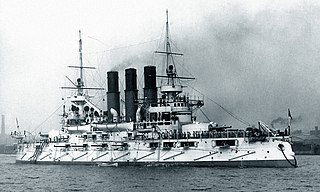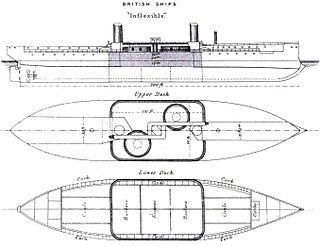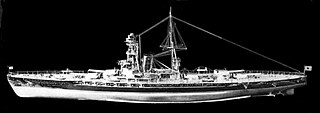Related Research Articles
A projectile is any object thrown by the exertion of a force. It can also be defined as an object launched into the space and allowed to move free under the influence of gravity and air resistance.Although any object in motion through space may be called projectiles, they are commonly found in warfare and sports. Mathematical equations of motion are used to analyze projectile trajectories.

The Nelson class was a class of two battleships of the British Royal Navy, built shortly after, and under the terms of, the Washington Naval Treaty of 1922. They were the only British battleships built between the Revenge class and the King George V class, ordered in 1936.

The King George V-class battleships were the most modern British battleships in commission during World War II. Five ships of this class were built: HMS King George V, HMS Prince of Wales (1941), HMS Duke of York (1941), HMS Anson (1942) and HMS Howe (1942).

HMS Hood was the last battlecruiser built for the Royal Navy. Commissioned in 1920, she was named after the 18th-century Admiral Samuel Hood. One of four Admiral-class battlecruisers ordered in mid-1916, Hood had design limitations, though her design was revised after the Battle of Jutland and improved while she was under construction. For this reason, she was the only ship of her class to be completed. Despite the appearance of new and more modern ship designs over time, Hood remained the largest warship in the world for 20 years after her commissioning, and her prestige was reflected in her nickname, "The Mighty Hood".

Mikasa (三笠) is a pre-dreadnought battleship built for the Imperial Japanese Navy (IJN) in the late 1890s. Named after Mount Mikasa in Nara, Japan, the ship served as the flagship of Vice Admiral Tōgō Heihachirō throughout the Russo-Japanese War of 1904–1905, including the Battle of Port Arthur on the second day of the war and the Battles of the Yellow Sea and Tsushima. Days after the end of the war, Mikasa's magazine accidentally exploded and sank the ship. She was salvaged and her repairs took over two years to complete. Afterwards, the ship served as a coast-defence ship during World War I and supported Japanese forces during the Siberian Intervention in the Russian Civil War.

The Lord Nelson class consisted of a pair of pre-dreadnought battleships built for the Royal Navy in the first decade of the twentieth century. Although they were the last British pre-dreadnoughts, both were completed and commissioned well over a year after HMS Dreadnought had entered service in late 1906. Lord Nelson and Agamemnon were assigned to the Home Fleet when completed in 1908, with the former ship often serving as a flagship. The sister ships were transferred to the Channel Fleet when the First World War began in August 1914. They were transferred to the Mediterranean Sea in early 1915 to participate in the Dardanelles Campaign.

Military vehicles are commonly armoured to withstand the impact of shrapnel, bullets, missiles or shells, protecting the personnel inside from enemy fire. Such vehicles include armoured fighting vehicles like tanks, aircraft and ships.
The torpedo belt was part of the armouring scheme in some warships between the 1920s and 1940s. It consisted of a series of lightly armoured compartments, extending laterally along a narrow belt that intersected the ship's waterline. In theory this belt would absorb the explosions from torpedoes, or any naval artillery shells that struck below the waterline, and thus minimize internal damage to the ship itself.

Retvizan was a pre-dreadnought battleship built before the Russo-Japanese War of 1904–1905 for the Imperial Russian Navy. She was built by the American William Cramp & Sons because Russian shipyards were already at full capacity. Named after a Swedish ship of the line that was captured during the battle of Vyborg Bay in 1790, Retvizan was briefly assigned to the Baltic Fleet, but was transferred to the Far East in 1902.

Gun laying is the process of aiming an artillery piece or turret, such as a gun, howitzer, or mortar, on land, in air, or at sea, against surface or aerial targets. It may be laying for direct fire, where the gun is aimed similarly to a rifle, or indirect fire, where firing data is calculated and applied to the sights. The term includes automated aiming using, for example, radar-derived target data and computer-controlled guns.
The Admiral-class battlecruisers were to have been a class of four British Royal Navy battlecruisers designed near the end of World War I. Their design began as an improved version of the Queen Elizabeth-class battleships, but it was recast as a battlecruiser after Admiral John Jellicoe, commander of the Grand Fleet, pointed out that there was no real need for more battleships, but that a number of German battlecruisers had been laid down that were superior to the bulk of the Grand Fleet's battlecruisers and the design was revised to counter these. The class was to have consisted of HMS Hood, Anson, Howe, and Rodney — all names of famous admirals — but the other three ships were suspended as the material and labour required to complete them was needed for higher-priority merchantmen and escort vessels. Their designs were updated to incorporate the lessons from the Battle of Jutland, but the Admiralty eventually decided that it was better to begin again with a clean-slate design so they were cancelled in 1919. No more battlecruisers would be built due to the arms limitations agreements of the interbellum.

The G3 battlecruisers were a class of battlecruisers planned by the Royal Navy after the end of World War I in response to naval expansion programmes by the United States and Japan. The four ships of this class would have been larger, faster and more heavily armed than any existing battleship. The G3s have been considered to be proper "fast battleships" since they were well-balanced designs with adequate protection. Nonetheless the class was officially designated as a "battlecruiser" due to their higher speed and lesser firepower and armour relative to the planned N3 class battleship design. The G3s carried nine 16-inch (406 mm) guns and were expected to achieve 32 knots, while the N3s would carry nine 18-inch (457 mm) guns on the same displacement at the expense of a slower speed.
The N3 class was a dreadnought battleship class designed for the Royal Navy after World War I, incorporating lessons learned from that conflict. They were similar in design to the G3-class battlecruiser, but had larger guns and thicker armour. They were never ordered due to signing of the Washington Naval Treaty in 1922, which limited the size and armament of battleships to 35,000 long tons (36,000 t) and no gun bigger than 16 inches (406 mm).

Belt armor is a layer of heavy metal armor plated onto or within the outer hulls of warships, typically on battleships, battlecruisers and cruisers, and aircraft carriers.

The South Dakota class was a group of four fast battleships built by the United States Navy. They were the second class of battleships to be named after the 40th state; the first were designed in the 1920s and canceled under the terms of the Washington Naval Treaty.

The dreadnought was the predominant type of battleship in the early 20th century. The first of the kind, the Royal Navy's Dreadnought, had such an impact when launched in 1906 that similar battleships built after her were referred to as "dreadnoughts," and earlier battleships became known as pre-dreadnoughts. Her design had two revolutionary features: an "all-big-gun" armament scheme, with an unprecedented number of heavy-calibre guns, and steam turbine propulsion. As dreadnoughts became a crucial symbol of national power, the arrival of these new warships renewed the naval arms race between the United Kingdom and Germany. Dreadnought races sprang up around the world, including in South America, lasting up to the beginning of World War I. Successive designs increased rapidly in size and made use of improvements in armament, armor, and propulsion throughout the dreadnought era. Within five years, new battleships outclassed Dreadnought herself. These more powerful vessels were known as "super-dreadnoughts". Most of the original dreadnoughts were scrapped after the end of World War I under the terms of the Washington Naval Treaty, but many of the newer super-dreadnoughts continued serving throughout World War II.

All or nothing is a method of naval warship armour, best known for its employment on dreadnought battleships. The concept involves heavily armoring the areas most important to a ship while the rest of the ship receives significantly less armor. The "all or nothing" concept avoided light or moderate thicknesses of armor: armor was used in the greatest practicable thickness or not at all, thereby providing "either total or negligible protection". Compared to previous armoring systems, "all or nothing" ships had thicker armor covering a smaller proportion of the hull. The ironclad battleship HMS Inflexible launched in 1876 had featured a heavily armored central citadel, with relatively unarmored ends; however, by the era of HMS Dreadnought, battleships were armored over the length of the ship with varying zones of heavy, moderate or light armor. The U.S. Navy adopted what was formally called "all or nothing" armor in the Standard-type battleships, starting with the Nevada class laid down in 1912. The Imperial Japanese Navy soon implemented the system in its Nagato-class battleships starting in 1917, and "All or Nothing" armor was later adopted by other navies after the First World War, beginning with the Royal Navy in its Nelson class.

The Tosa-class battleships were two dreadnoughts ordered as part of the "Eight-Eight" fleet for the Imperial Japanese Navy (IJN) during the early 1920s. The ships were larger versions of the preceding Nagato class, and carried an additional 41-centimeter (16.1 in) twin-gun turret. The design for the class served as a basis for the Amagi-class battlecruisers.

The Shikishima class was a two-ship class of pre-dreadnought battleships built for the Imperial Japanese Navy in the late 1890s. As Japan lacked the industrial capacity to build such warships herself, they were designed and built in the UK. The ships participated in the Russo-Japanese War of 1904–1905, including the Battle of Port Arthur on the second day of the war. Hatsuse sank after striking two mines off Port Arthur in May 1904. Shikishima fought in the Battles of the Yellow Sea and Tsushima and was lightly damaged in the latter action, although shells prematurely exploded in the barrels of her main guns in each battle. The ship was reclassified as a coast defence ship in 1921 and served as a training ship for the rest of her career. She was disarmed and hulked in 1923 and finally broken up for scrap in 1948.
Naval armour refers to the various protections schemes employed by warships, and is distinguished from other kinds of armour. Naval sailing ships have had protection from weaponry since at least Ancient times, when Greek and Roman warships used simple cladding. As weapons evolved and became more destructive, naval armour became an important part of warships. Korean and European ships began to use some iron plating in the 1500s. The first ironclad warship was created in 1859, and the pace of armour advancement accelerated quickly thereafter. The emergence of battleships around the turn of the 20th century saw ships become increasingly large and well armoured. Vast quantities of heavily armoured ships were used during the World Wars, and were crucial in the outcome. The emergence of guided missiles in the last part of the 20th century has greatly reduced the utility of armor, and most modern warships are now only lightly armored.